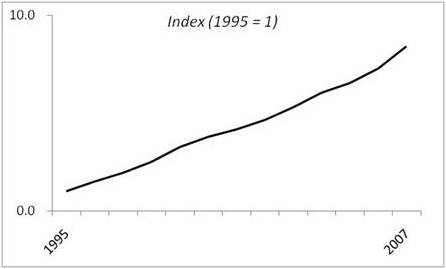OSCON and Everything After
by Bryan Kirschner on August 29, 2007 01:09am
When I describe my job as “helping Microsoft and open source to grow together,” I get a broad range of reactions from people outside and inside of Microsoft. These reactions have included sentiments along the lines of “that must be tough,” or “you must be a glutton for punishment” on occasion.
After wrapping up a fairly momentous year* culminating in OSCON (see this and this), I thought the time was right to put some big-picture context around how I feel about my job.
The year 1995 was when we saw the first official public release (0.6.2) of the Apache server, and MySQL AB was founded.
The world was two years shy of the Debian Software Guidelines and three years away from the articulation of the Open Source Definition (OSD) they inspired.
The Open Source Technology Group (OSTG)—by virtue of operating both Sourceforge and Freshmeat today’s largest hoster of public open source project--was about to be founded.
We were at the very beginning of the growth of open source into a significant, enduring part of the IT environment.
So what’s this graph below showing over the course of (roughly) 1995 through 2007?

It’s showing Microsoft’s reported fiscal year revenue, which grew to $51.122B USD in 2007 from $6.075B in 1995 (you can reproduce it with data from here.)
During most of this time, we didn’t have Codeplex.
We didn’t have licenses submitted to the OSI.
We didn’t have Port 25.
We didn’t have Bill Hilf, or Sam Ramji, or the rest of the OSS lab.
And we didn’t have https://microsoft.com/opensource.
And Microsoft and open source did grow, together—coincidentally. In retrospect, this is not surprising. Microsoft technologies supported an ecosystem of passionate developers and an entrepreneurial individuals and companies and tens of millions of end-user programmers and end-users providing peer-to-peer assistance sharing knowledge—and code—with each other.
And we had many people at Microsoft working on (to highlight some of my current favorites) the research and development and product management path to technologies like Silverlight and XNA and Photosynth.
Now we have all those things—plus the opportunity to think every day about the “growing together” that has happened coincidentally from (say) 1995 until July 2007—and how we might work together with others to make it that much more (--food for thought: MySQL’s Community VP Kaj Arno blogged about the WAMP stack just after OSCON here).
There are reasons why my job can be challenging sometimes—but the slightest concern that Microsoft and open source don’t have opportunities to “grow together” by design faster and farther than they have (largely)** “by accident” over the last 10 plus years isn’t among them.
The “official” t-shirt of the Open Source Software Lab at Microsoft says “Open Source Software Lab at Microsoft: Reports of Snowballs Seen in Hell.” This year was another step forward to replacing that slogan with “Open Source Software Lab at Microsoft: Of Course.” Then I’ll get the answer I give back to people when I describe my job: not tough. Cool.
*I have internalized a July-to-June fiscal year calendar. I attribute this to the fact that my wife works in education, so summer forms an annual breakpoint for her, as well as to the fact I worked in Finance during a point in my life when I think I mistook a love of math for an affinity for pain.
**There’s more than enough material for, and reason to do, a separate post about some of the individual “pioneers” at Microsoft, without whom we would not have the resources we have in place today here at Microsoft.